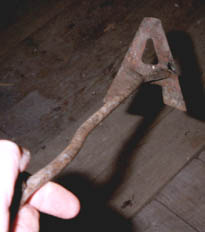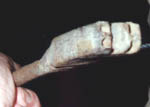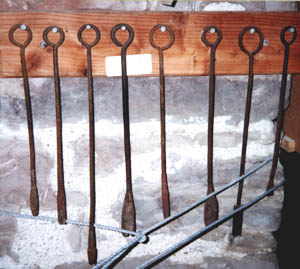Woolmarks and horn burns

The Museum has several sheep markers in different sizes. Some are for marking the sheep's newly shorn fleece with hot tar or dye, so she is identifiable as belonging to a particular farm. The "smit mark" only lasts until she is shorn again, but it is easy to read from some distance away.
Failing to mark a sheep after clipping may mean she can't be identified if she strays or if she's stolen: hence the expression, "losing the sheep for a ha'porth of tar". The letter A may stand for the owner's surname, or the farm name, such as Aldby. An alternative interpretation of the "ha'porth of tar" may be a reference to the "salving" of sheep.
Some of these markers are for branding the ewe's horns. A "horn burn" is smaller than the fleece mark, but more permanent. The ewe will carry her horns and the horn burn all her life, unless she is poorly fed at some time. Then she may grow a weak section of horn and lose the horn by an accident.

Left: The business end of a horn brand, the letters E H (for Edward Hasell) or if used upside down, H E!

Right: An assortment of horn brands. Each farm had a set with its own letters; several were needed, so that some were heating while others were in use.
Farms with common grazing on the fell used this system combined with "lug marks" - specific shapes snipped out of the ear - and smit marks. Today all sheep have to carry ear-tags which identify which farm they came from, and the tags are individually numbered for each animal.